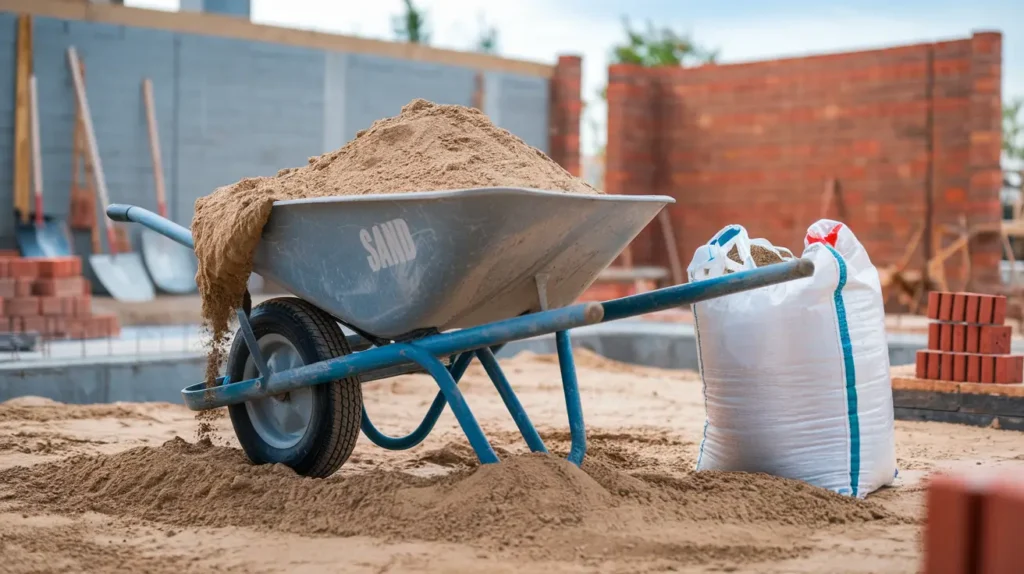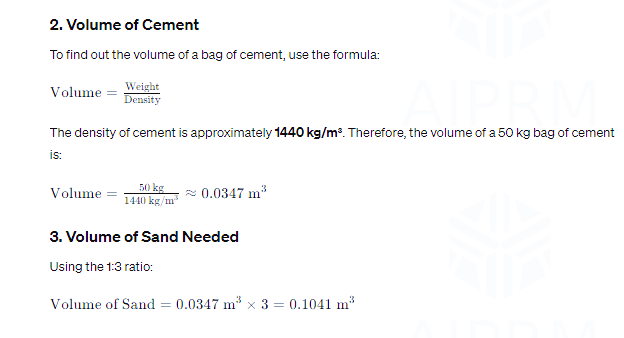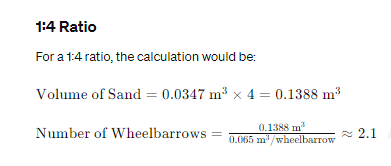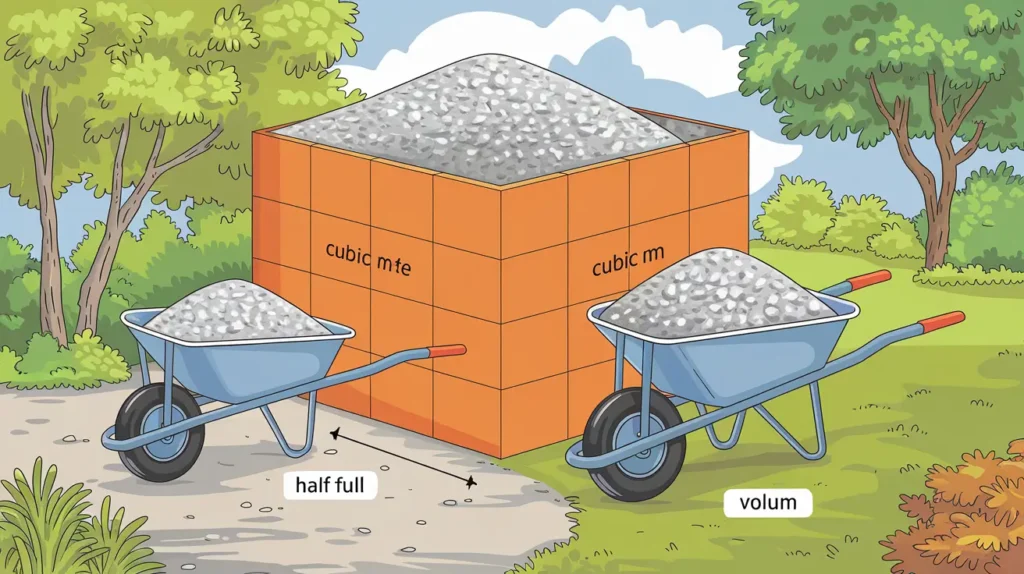The Ultimate Guide: How Many Wheelbarrows of Sand Per Bag of Cement
Are You Wondering: “How Many Wheelbarrows of Sand Per Bag of Cement?” Are You Attempting a DIY Project or Running a Construction Site? Creating the optimal mixture between cement and sand can be tricky business, as the exact ratio can depend on different scenarios; to help answer the age-old question of “How Many Wheelbarrows of Sand to a Bag of Cement?”.
This comprehensive guide covers each situation as well as providing instructions and guidelines to make mixing concrete simpler than ever!
How Many Wheelbarrows of Sand to a Bag of Cement for Concrete
Mixing cement with sand in proportion is of the utmost importance. For general use concrete mixes, two to three wheelbarrows aggregate should be mixed per container of cement. This makes an extremely strong mix that is well suited for multiple uses.
Keep in mind that the ideal ratio may differ depending on the specifics of your project. Factors such as strength desired from the concrete, aggregate dimensions and motivation all play a part in determining an optimum mix ratio between cement and sand.
Block-making requires an unusual mixture of concrete, which requires 1 to 1.5 wheelbarrows filled with sand to produce 1 bag of cement to make blocks that will stand up against pressure and the weather elements.
How Many Wheelbarrow of Sand for 1 Bag of Cement

A commonly used rule of thumb for all project is using as much as two wheelbarrows of sand for each container of concrete. This is the ideal proportion that works for
- Foundation work
- Slab pouring
- General concrete repairs
- The pathways and drives
However, it’s essential to remember that this ratio could be altered based on the specific needs of the particular project. For example, when you’re working on projects that have an equal mix of sand, it may be possible to decrease the amount of sand.
Understanding Cement and Sand Ratio
Proper cement-sand ratio is vital in creating solid and long-lasting mixes. Common ratios used are:
Cement and Sand Ratio
The cement and sand ratio is essential for creating a strong and durable mix. The most common ratios are:
- 1.2 (one component cement to two components sand) should be used for plastering purposes,
- 1:3 for general purposes
- 1:4 or 1:5 ratio is suitable for foundation building as well as heavy-duty construction applications.
These ratios could change depending on your project-specific requirements.
For More Interesting and Informative Articles Check out: smartoolbuddy
Standard Bag of Cement
A typical cement bag typically weighs 50 kilograms (110 pounds), making it the go-to size for construction projects around the world.
Wheelbarrow Capacity
While wheelbarrow sizes and capacities can vary greatly, a typical construction wheelbarrow typically holds around 65 liters (roughly 0.06 cubic meters) of material. Please keep in mind that capacity may depend on factors like its dimensions and shape of course.
How Many Wheelbarrows of Sand Make a Tipper
Knowing the number of wheelbarrows of sand that could be equivalent to a tipper load can help with projects that are massive in scope. On average a tipper truck capable of storing 40-50 wheelbarrows filled with the sand. The amount of sand depends upon:
- The dimensions of the tipper are the exact same dimensions as the truck’s dimensions.
- Wheelbarrows are able to support the weight of many kilograms.
- The nature and content of the sand’s water.
The knowledge of this modification could assist with estimating how much sand needed for your project. It will assist you in making deliveries of materials faster.
Calculating the Number of Wheelbarrows with Sand

1. Determine the Sand Requirement
To start off, it’s essential that you know how many wheelbarrows of sand to a bag of cement you require depending on your mix ratio. For instance, using a 1:3 mix ratio would require three times as much sand.

4. Convert to Wheelbarrows
To convert the volume of sand to the number of wheelbarrows, divide the volume of sand by the volume capacity of a wheelbarrow


Also Read: Difference Between Wheelbarrow and wheelbarrel
How Many Wheelbarrows in a Cubic Meter?

The cubic-meter can be an important measurement for construction, especially in relation to bulk materials like gravel, sand or concrete. One cubic millimeter of substance is equal to about 12-14 wheelbarrows dependent on the dimensions of the wheelbarrow as well as the substance is being measured.
It is especially useful in the following scenarios:
- To place the bulk purchase for materials
- Calculating the amount of trips required for the transportation of materials
- The calculation of the amount of excavation or fill needed for completing a project.
How Many Wheelbarrows in a Meter of Concrete?
If you are working using concrete, you need to determine the amount of wheelbarrows needed to transport a millimeter of mix. On average 1 cubic meter of concrete is the equivalent of 12-14 wheelbarrows. This is dependent on the capacity a wheelbarrow is able to hold that is between 70 and eight liters.
It is important to be aware of the variety of issues to be considered like:
- Concrete mix’s cohesion
- The degree of competence of the person responsible for the wheelbarrow
- This is the terrain on which you will find your construction site
Each of the variables affect the number of wheelbarrows that need to be used to transport one cubic millimeter of concrete.
How Many Wheelbarrows of Sand to a bag of cement Make a Ton
Sand can be typically sold per ton of weight, and is the most frequently used measurement units. On the average, one ton sand weighs between 15 and 17 wheelbarrows. The cost will vary depending the following factors:
- The quantity of soil’s water content can be measured by the sand
- The kind of sand (fine coarse fine, fine and so on.)
- An ability for a wheelbarrow
How Many Wheelbarrows in 1m3 of Concrete
We have mentioned in the past that we’ve said how one cubic centimeter (1m3) within concrete usually is equivalent to 12 to 14 wheelbarrows. This measurement is essential for:
- The complex nature in the pouring of concrete
- Minimum specifications for workforce for a particular job
- calculation of amount of hours required for transporting cement from the mixing area to the location where it will be poured.
Be aware that the number may be different based on how good the quality of the concrete mix are as well as the size of the wheelbarrow being used.
How Many Wheelbarrows Per Yard
If you’re using yards as a measurement unit, measurement, you must be aware that a cubic yard corresponds to around 0.765 cubic meters. With this method, you can calculate the amount of cubic meter of materials, it could be anywhere from nine to eleven wheelbarrows.
- The weight of a wheelbarrow is about 1/15th to one-fifth of one cubic yard
- It’s estimated to take between 15 and 17 wheelbarrow loads in order to create a full cubic yard
- Its conversion could differ based on the method by which it is loaded as well as the type of material used
How Many Wheelbarrows in a Cubic Meter of Soil?
Soil It is like cement, sand and concrete and is measured typically by cubic meters. On average one cubic meter of soil may include 12 to 14 wheelbarrows. This can vary depending upon wheelbarrows in a cubic meter of soil:
- The soil type (clay loam or sandy)
- The content of moisture of soil.
- How dense is the soil in the wheelbarrow?
Practical Application: Sand-to-Cement Ratio Table
To aid you determine the right proportion of cement to sand to meet your needs, here’s a sample table:
| Application | Cement (Parts) | Sand (Parts) | Wheelbarrows of Sand per Bag of Cement |
| General Concrete | 1 | 2 | 2-3 |
| High-Strength Concrete | 1 | 1.5 | 1.5-2 |
| Mortar for Brickwork | 1 | 3 | 3-4 |
| Concrete Blocks | 1 | 1.5 | 1.5-2 |
| Screed | 1 | 3-4 | 3-4 |
| Rendering | 1 | 2-3 | 2-3 |
Please note that these are only guidelines that may require changes in accordance with specific project requirements and local building codes or even the weather conditions.
To browse and buy best Wheelbarrow, check out on Amazon . For more insightful blog posts on the tools and techniques and gear reviews, make sure to visit Smart Tool Buddy. Our site has a wide array of tools and resources for beginners and experienced who want to improve their skills.
Conclusion
Knowing the right proportion of cement to sand is vital for success in DIY or construction initiatives. If you’re mixing concrete, building blocks or working with a lot of materials, the knowledge provided in this article will assist you make educated decisions and produce the highest high-quality results. Hope so you’ll find the answer of How Many Wheelbarrows of Sand Per Bag of Cement?
Be aware that although general guidelines are useful but the climate in your area as well as the specifications of your project and the nature of the material may affect the optimal proportion of sand to cement. If you are unsure, speak to someone who is an expert, or run some small tests to find the most suitable mix to satisfy your specific needs. this guide provides all the steps and guidelines to create your ideal concrete mixer.
Frequently Asked Questions on How Many Wheelbarrows of Sand to a Bag of Cement Required
How much sand do I need to mix with one bag of cement?
Standard mixing ratio for cement should require two to three wheelbarrows per bag of cement; exact number may depend upon size and ratio of your wheelbarrows.
How many bags of cement do I require?
Sand is required for each bag of cement weighing about 94 pounds (42.6 kg), equivalent to two or three wheelbarrow loads, given that each wheelbarrow holds roughly two cubic feet of material.
What ratio exists between one bag of cement and sand?
Cement and sand typically use a ratio of 1:1:3. When mixing bagged concrete, three bags should be mixed into the mix for every part of cement used. Likewise, any time an additional part of sand is added for every bag that goes in as part of its content.
How much sand do you mix with a bag of concrete?
Concrete mixing should typically consist of one part cement, two parts sand and three parts aggregate (gravel). So if you have one bag of cement in your possession, mix it with two parts of sand and three of gravel.
Also Read: How Much Does a Tree Trimmer Make an Hour?


Related Blogs
Affordable Bluetooth Projector for Gaming: The Best in 2024
The Best Soundbar for Music and Movies for Home Threaters
Stay Powered Up: The Best Portable Charger for iPhone 15 in 2024
The iPhone 15 Pro Max New Features: Comprehensive Features
Liquid Screen Protector vs Tempered Glass: Which is better in 2024
What is a Monkey Wrench: Complete Details
Guide to Cleaning Your Gatorade Bottle The Proper Way
How To Sharpen Garden Hoe: Real Guide to the problem
How to Use a Tack Hammer Nail it Every Time
Easy Ways on How to Clean Garden Tools at Home
Changing a Garden Cart Tire: Expert Hacks That Will Save You from $200+ in Repairs
How to Whisk Eggs: Easy Manual Techniques
Garden Fork Vs Pitchfork: Deciding Which Tool Will Meet Your Garden Needs
Conquering the Greens: How to Rake Artificial Grass
How Deep To Plant Daffodil Bulbs? A Simple Guide
How to Pick the Best Shovel for Digging in 2024
The best time to power rake your lawn
Why Your Kitchen Isn’t Complete Without an Acacia Cutting Board
How to Replace Trimmer Line in Bump Feed: Step-by-Step Guide
Perfect Make Matcha Without Whisk: The Ultimate Guide
10 Ways to Remove Snow from Driveway Without a Shovel: Innovative Snow Removal
Don’t Make This Silly Mistake with Your 5 Uses of Garden Fork
Is a Spade and a Shovel the Same? Discover the Differences Here
Transform Your Garden with Stunning Garden Stake Ideas You’ll Love
The Best Home Gym Equipment you can get in 2024
The Best Home Gym Setups for Small Spaces
Shoot Like a Pro: The Best iPhone Filmmaking Kit
Are Bone Conduction Headphones Safe?
Revolutionize Your Visual Experience: Best Samsung CF39 Series in 2024
The Benefits of Using a Point to Point Wireless Bridge for Your Business
Samsung T7 SSD Review: The Best and Fastest Portable SSD for 2024